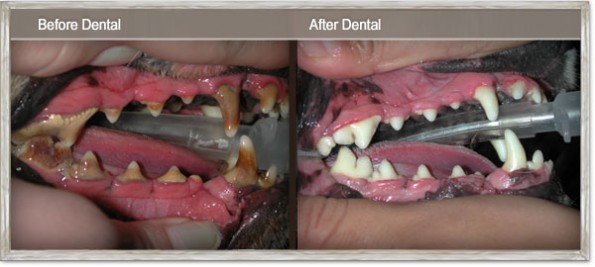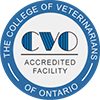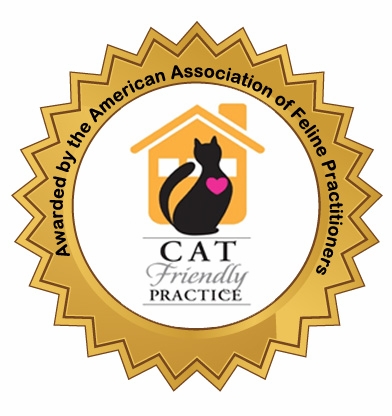
DENTAL HEALTH MONTH – Fixing Smelly Situations!
Does your pet have discolored teeth? Do they not like you to touch or look in their mouth? Can you barely stand to snuggle them anymore because of their stinky breath? These are not uncommon complaints from owners at all and it usually means that their pet has some degree of dental disease! Dental disease not only causes nasty breath, it can also cause many other more dangerous issues in our pets. Read on to find out more!
Imagine if you didn’t brush your teeth or see the dentist…ever…what your mouth would be like? This is often the situation for our pets. Without regular dental care the tartar in our pet’s mouths will start to build on the teeth and under the gumline, and it’s this bacteria-filled tartar that causes dental disease.
Dental disease ranges from minor dental plaque and gingivitis (inflamed gums) all the way up to abscessed teeth which are diseased and painful for our pets! Dental health is something that we evaluate superficially when you bring your pet in to see us once or twice per year for their wellness examination and we will likely have some recommendations for you for your pet’s dental health each time they come in to see us. It’s one of the most important areas of your pet’s health!
So, all that being said, how and why is dental health so important for our pets? So he/she has smelly breath…animals are supposed to have smelly breath, right?! This is a VERY common misconception! Your pet’s breath should NOT be offensive! If it is, it means that there’s an overgrowth of bacteria in the mouth and this is very unhealthy for them for several reasons. First of all, that level of bacteria in the mouth and under the gumline can be very uncomfortable for them as it causes inflammation. Secondly, the bacteria that build up along the gumline and under the gums are constantly being showered into the blood stream. These little bacteria can then gain access to your pet’s major organs, most commonly the heart, kidneys, lungs, and joints, and this can cause major serious diseases for them long term. If their mouths are unhealthy, the rest of their bodies are unhealthy too!
When dental disease is not attended to properly and left to advance into later stages, teeth become abscessed and moveable in the mouth, and this is PAINFUL! The interesting thing is that most animals WILL NOT stop eating or playing with their toys even though their mouths are in a LOT of pain, but, they may instead show their pain in different ways. Sleeping more, being less active and willing to socialize, becoming more aggressive or hiding more, drooling, or coughing can all be signs of oral pain in our pets. Some pets don’t show any of these signs outwardly, but realistically, if you had infection in your mouth to the point of your teeth rotting and falling out, how could that NOT be painful!?
So, the major question is “How do I keep up with my pet’s oral health and how do I fix dental disease to allow them to live a long and happy life free of oral pain?” For prevention there are several things that you can implement into your pets routine, and these are best implemented early on, including:
- Brushing their teeth! This is the #1 best way to keep dental disease away, but it can be difficult! If you start with your pet when they are very young you are more likely to have success, but for this to be effective they must have their teeth brushed with an enzymatic veterinary toothpaste at least once per day!
- Dental foods clinically proven to prevent and remove plaque and tartar such as Hill’s T/D or MediCal Dental kibbles. If you can’t reliably brush your pets’ teeth then this is the next best thing! It basically brushes their teeth every time they eat!
- Dental chews and treats (be careful though as these can be very high in calories!)
- Water additives that can be put into your pets’ water daily to minimize oral bacteria
- Oral antibacterial gels
If your pet already has a lot of tartar, diseased teeth or very smelly breath, the only fix for that is a professional dental cleaning. This involves putting your pet under anesthesia to properly examine, x-ray, clean, polish and fluoride your pet’s entire mouth. There is NO way to properly clean under the gumline in pets that are awake as it is uncomfortable to do this, so they must be asleep for the procedure. IT IS NOT SAFE FOR PETS TO UNDERGO ANESTHESIA FREE DENTISTRY as it can cause damage to teeth, no cleaning can be done under the gumline, and no xrays or extractions can be done! We can also surgically extract any teeth that are diseased or abscessed to help your pet feel better and be as healthy as they can be!
X-rays are a big part of our examination of your pets’ teeth because it shows us what is going on under the gumline at the level of the tooth roots. It allows us to detect disease processes that don’t necessarily show up just by looking at their teeth from the outside, which is very important.
What about broken teeth? These cause a HUGE problem for pets, even if they don’t seem painful. If the pulp of the tooth is exposed, that leaves a direct route for mouth bacteria into the blood stream, even if they don’t have heavy tartar! Over time this WILL cause disease and pain, so it is always better to have any broken teeth examined under general anesthesia, x-rayed, and extracted if necessary to avoid issues for your furry family member!
Start the New Year off by giving your pet the gift of a healthy mouth for 2018! Call us to book your pet in for a dental assessment today!
Dr. Christine Nawas, BSc, DVM
(c) Erin Mills Pet Hospital 2018



